The Dot-Connector: How the League of Nations Incidentally gave Birth to Neoliberalism
Hagen Schulz-Forberg (Associate Professor - Aarhus University)
Children love it: Connecting the numbered dots on an otherwise blank page. Doing so, an image emerges that in most cases is more complex than previously thought. Quite often, the image that takes shape when connecting the dots, could not quite be figured out before. One is up for a surprise. In transnational history, the League of Nations is quite similar to such a dot connecting drawing game as its study yields increasingly complex images of the transnational past. The global claims of the Mandate system in a world shifting from imperial to nation-state order is one of those complex images; the increasingly more nuanced history of international law another.[1]
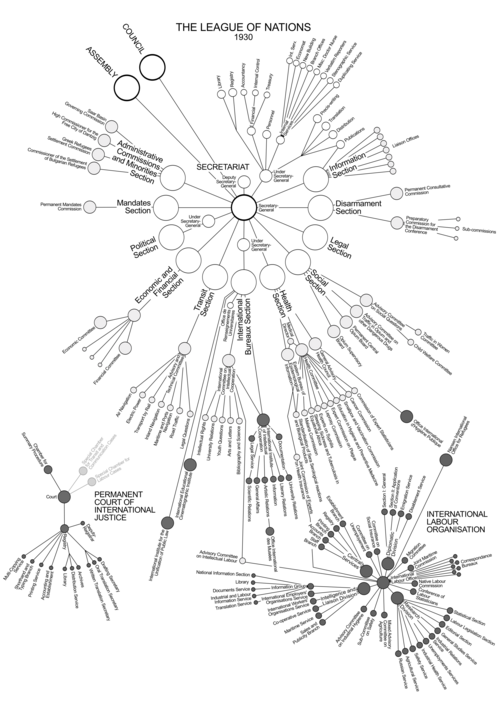
Many connected dots: Organizational map of the League of Nations
For economic thought and the beginnings of neoliberalism, the League does not only appear as the maker and self-proclaimed savior of civilization and the kind of world economy needed to sustain it, indeed, the various schools of thought in economics, such as the early Chicago School, the Lausanne School, or the Geneva School, can be connected via the League’s institutional tentacles and its overall mission and normative drive towards thinking in peaceful global orders.
The League created a complex global landscape of research and policy-making in which connected institutions carried out research with a mission. In some countries, existing institutions for the study of international affairs or social and economic policies served as the source of expertise, particularly the London School of Economics(LSE), whereas in countries that lacked such an institution, it was founded. The Instituto de Estudios Internacionales y Económicosin Madrid, for example, began its work in early 1931.[2] A kind of early version of private-public-partnership was practiced. The League chipped in financially together with the member state’s government and the Rockefeller Foundation.
Within the web established by an increasing number of institutional dots, neoliberalism took shape as an unintended consequence of larger efforts at conceptualizing world peace and its economic design. What is the relation between markets and peace? What is the role of economics for peaceful change? How and based on which economic basic grid can collective security be organized nationally and internationally? And vice versa, which economic conditions lead to insecurity? In a man-made world, which basic norms and values should inform economic and social organization?
A global web
What the League created throughout the 1920s and 30s to address these and more questions was a landscape of research institutions with a global spread. The organization was complex and mainly facilitated by the League’s various secretariats, the International Committee for Intellectual Co-operation (ICIC) and its operationalizing arm in Paris, the International Institute for Intellectual Co-operation (IIIC) and the International Studies Conference (ISC) that emerged within the IIIC and its own more official institutionalization in 1929 (see Søren Friis’ contribution to this blog). Each member state joined with its major dots, that is: its leading research institutions. National institutions were gathered under the umbrella of National Committees for Intellectual Co-operation (NCICs) to which specialized committees were attached, for example for International Studies. The practice of establishing national research hotspots was carried out consistently in the member states.
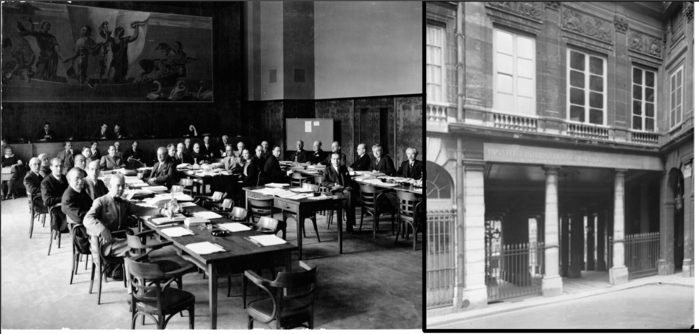
ICIC Plenary Session 1939 (left) and a side of the Palais-Royal (Paris), where the IIIC was installed in 1926 (right).
The reach and complexity of these webs become apparent when looking at the tenth ISC conference of 1937. It needed ten preliminary meetings on specific sub-topics held in Geneva, London, Paris and Vienna. The conference then had to digest more than one hundred memoranda from Australia, Canada, the United States and thirteen European countries. Overall, 142 participants came to Paris for a week, representing twenty national research institutes and national coordinating committees. They came mostly from Europe, but also from Australia, Brazil, Canada and the US (which, despite not being a member of the League, nevertheless ran its own national committees closely connected to the IIIC and ISC throughout). Five countries sent invited experts or observers: China, Germany, Italy, Japan and Mexico. Germany and Italy had participated prominently at meetings and conferences until leaving the League. Furthermore, organizations grouped under the headline “international” also participated or sent experts: the Carnegie Endowment, the Rockefeller Foundation, the Pacific Institute of International Affairs, the Graduate Institute of International Studies in Geneva, the Academy of International Law, the New Commonwealth Institute (which published Hayek’s essay on the effect inter-state federation might have on the economy – seen by many as an original script for contemporary neoliberalism[3]) and the International Labour Organisation (ILO) came to the ISCs.[4]
From Hamburg to Honolulu - to Christchurch
The task of the emerging landscape was to produce sustainable policies for global order and the necessary elite personnel to staff the dots. Each of the larger questions mentioned above were broken down into smaller research questions and divided among the participating institutions. In many cases, the actors shaping this world of research were able to build their careers within the institutional web that spun its threads from, for example, Hamburg’s Institut für Auswärtige Politik, founded in 1923, to Honolulu’s Institute of Pacific Relationsfrom 1925, to indeed the city of Christchurch in New Zealand, where a certain John Bell Condliffe (1891-1981) received his MA in economics in 1915 and began lecturing on economics, constitutional history and economic thought in 1916. Condliffe is not among the intellectually more prominent early neoliberals. Yet his biography illuminates the effects of the League’s institutional and intellectual landscape, particularly during the 1930s when neoliberalism found its discursive shape and was named so at the Walter Lippmann Colloquium from August 1938 amidst the presence of Condliffe and twenty-five further participants.[5]
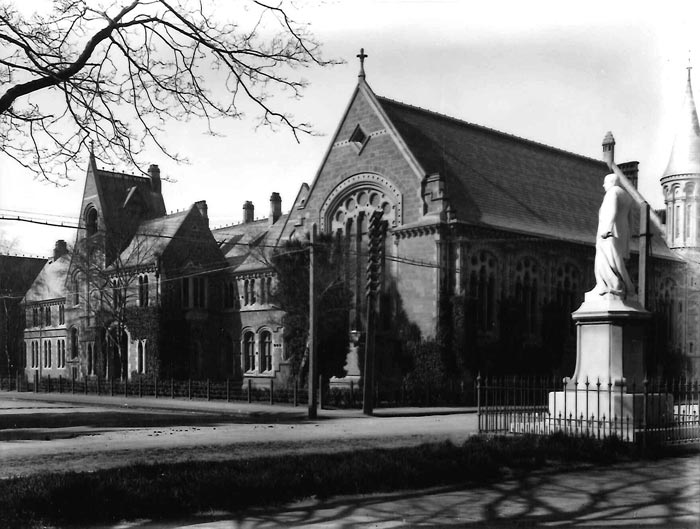
One of the dots: Canterbury College in Christchurch (ca. 1880)
Originally from Footscray, Victoria, in Australia, Condliffe attended Canterbury College in Christchurch after his family relocated to New Zealand in 1904. Following his prize-winning MA (the first ever economic history of New Zealand based on the systematic use of trade statistics) and his first experience as a lecturer, Condliffe became engulfed in the First World War. Wounded on the battlefields near Ypers in February 1918, he gained a scholarship for Cambridge University. There, John Maynard Keynes made a lasting impression on him, not only intellectually, but also on the level of agency, driving home the insight that economics needed to tackle and propose policy solutions for the urgent problems of the time. In 1920, he picked things up again in Christchurch, this time as professor of economics. Remaining close to policy-making, Condliffe was affiliated with the Canterbury Chamber of Commerce and on a monthly basis published analyses of economic events and policy. Condliffe would write reports, memoranda, protocols or reviews of events and proceedings throughout his career. He was a prolific academic writer, too, but his administrative-academic and policy-related publications had a more lasting effect. It peaked during his time at the League’s Economic Intelligence Service from 1931 to 1939. Before joining Geneva, Condliffe had changed address from Christchurch to Honolulu, where he began work as research director in 1926. While based on Hawaii, his responsibilities saw him touring the globe, organizing conferences and research projects in China, Japan, America as well as Europe.[6]
From Geneva to London – to Christchurch
The following eight years saw Condliffe managing an impressive workload. He authored the final report of the World Economic Conference from 1933 and put together the first World Economic Survey(and the following five) based on data from the intelligence service and the ILO.[7] The surveys were the first and most authoritative documents about the Great Depression, providing data, explanations and visualisations for a crisis unprecedented. As Quinn Slobodian remarks, the graphic depiction of the global economy’s contraction in the 1930s could rightly be called the Condliffe graph.[8]
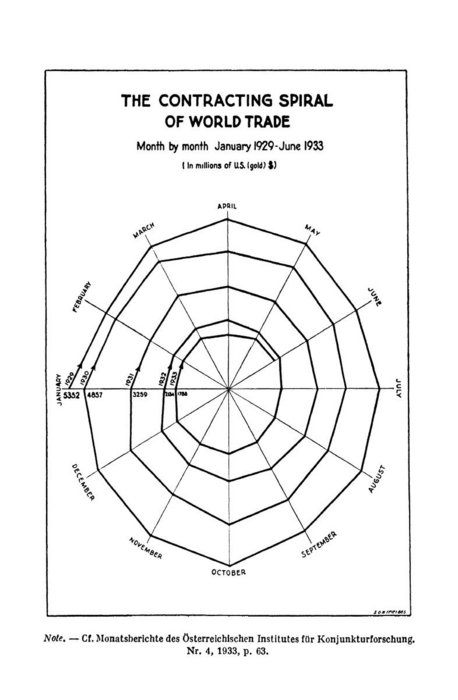
A so-called Condliffe Graph – a potent visualization of economic decline
As if this was not sufficiently demanding, Condliffe became research manager for the collaboration between the Rockefeller Foundation and the IIIC, and changed the way in which the ISC went about organizing its conferences fundamentally (and efficiently). The ISC’s two-year study cycles (since 1932) were introduced, with the Rockefeller Foundation increasingly influencing its overall design. Condliffe became the official rapporteur of the ISC, a go-between from private foundations to international organizations and research institutions. Highly trusted by the foundation, he also wrote a stream of letters of reference for colleagues who applied for Rockefeller fellowships. In 1938, he joined the LSE as a lecturer and, needless to say, continued to write reports, for example for the International Chamber of Commerce Congress in Copenhagen in June 1939,[9] and was member of the Committee on International Economic Policy at the Carnegie Endowment for International Peace.
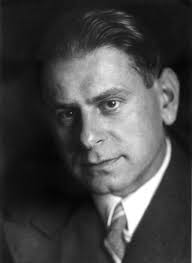
A young Karl Popper
While in London, Condliffe surely ran into Hayek and possibly also the talented and wealthy young economics student David Rockefeller (who studied with Hayek from late 1937 onwards). He did not meet another crucial figure of postwar neoliberalism associated with the LSE, however, even though he shared a lot with him. The scholar in question was at the other end of the globe at the time, in New Zealand: it was Karl Popper.
Popper rose to fame during his time at the LSE. Yet, The Open Society and Its Enemieswas written in Christchurch, at Canterbury College, Condliffe’s alma mater. Before moving to New Zealand, Popper visited London for some months and made the acquaintance of Hayek. Sometime in 1936, he came across a job announcement for a position to be filled – in New Zealand. It is not clear, how Popper learned about the position. Yet the simple fact that job announcements for rather remote places apparently fluttered through the transnational system illustrates just how wide the web was spun by the mid-1930s.[10]
The Incidental Birth of Neoliberalism
The events preceding the Walter Lippmann Colloquium that are of importance for the birth of neoliberalism include the ISC conferences since 1932, the Danubian Studies group and a string of conferences organized by the IIIC in collaboration with the Rockefeller Foundation, in particular the Economists’ Conference held in Annecy in 1936 and the meetings of the Permanent Committee of Business Cycle Institutes that was created as a follow-up of Annecy.[11] The League commissioned and broadly supported emergent forms of economic research: statistics, econometrics, macro-economics, business cycle research and economic as well as scientific theory in more general terms. Leading economists of the time worked within the League’s system of institutional affiliations. Neoliberalism developed within this world of transnational deliberation and it continued to nest within the fabric of international organizations alongside and in contestation with other perspectives.
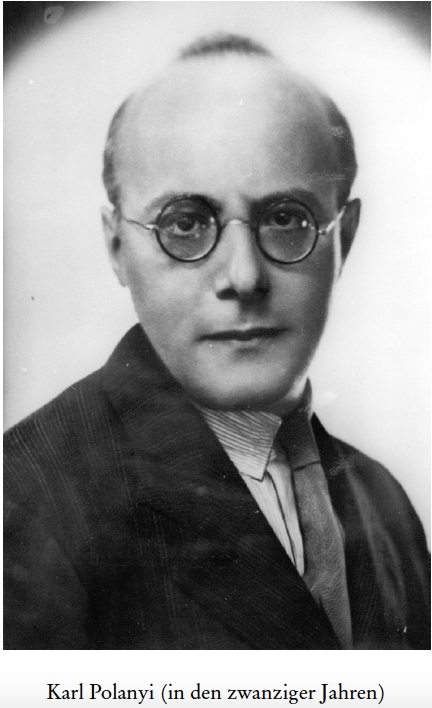
Condliffe was not among the handful of economists whose ideas changed the rules of the game, but he was a leading figure among those who then played the game itself. He pronounced his arguments with the urgency of a politically conscious intellectual. Neoliberalism had been defined as a certain way of organizing the state in 1938. It needed to guard the price mechanism, establish the rule of law and was allowed to raise taxes for defense, social security, education, social insurance and scientific research. This much was agreed upon in the ‘agenda of liberalism’ identified as neoliberalism at the time.[12] Condliffe’s dedication to the project (despite his Keynesian leanings) of rebuilding global order transpires from his remarks at the colloquium:
“Those who are here are convinced that the liberal philosophy is the best one: but they cannot be in agreement with restricting themselves to an apologia for a bygone economic system. (…) It will be necessary to reduce monopolies, re-establish the equality of classes, notably in education. (…) It is necessary to make clear and understandable to the mass the social role of the system, that is to say how work must contribute to the enrichment of all.”[13]
There were surely more eloquent and elaborate contributions to the discussion, but Condliffe’s convictions sum up what neoliberalism needed to achieve. His influence and references supported highly relevant and influential research. In his function as a go-between he facilitated the groundbreaking work of others. Without the transnational landscape of the League’s research and policy-making institutions, this would simply not have been possible. Condliffe would probably not have been asked to write a recommendation in the early 1940s for a Hungarian émigré who applied for a Rockefeller grant in support of his book project. His enthusiastic recommendation for Karl Polanyi resulted in a two-year fellowship and the ensuing publication, The Great Transformation, inspiring scholars to this day.[14] Meanwhile, reaching out from Christchurch with a finished manuscript, Popper remembered that Condliffe was a Canterbury College alumnus and a friend of his own old acquaintance from the mid-1920s onwards, the same Karl Polanyi. He decided to send him his manuscript. Condliffe handed the script to Alfred Braunthal and through the latter, The Open Society and Its Enemies arrived at Routledge.[15]
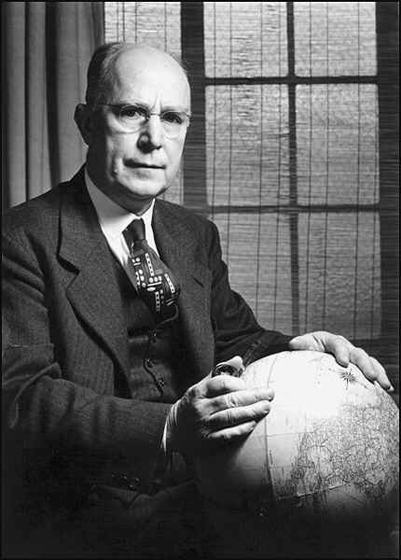
Condliffe carefully caressing the globe
The landscape of the League
Condliffe’s career is exemplary for the illustration of the League’s transnational research and policy-making landscape’s breadth and depth. Its cosmos brought forth a wide variety of perspectives on how to run the state and the economy. Condliffe was part of the process in leading and decisive positions, directly involved in facilitating projects, events and publications, and, almost as a side effect, he participated in the making and publication of two of the most long-standing achievements in twentieth century social theory. Taking Condliffe as the starting dot, the image that emerges is one of a large, transnational research network that gave birth to an incredible amount of innovations in the social and political sciences. One was neoliberalism.
References:
[1] Pedersen, S. (2015). The Guardians: The League of Nations and the Crisis of Empire. Oxford University Press. Anghie, A. (2005). Imperialism, Sovereignty and the Making of International Law. Cambridge University Press. Koskenniemi, M. (2001). The Gentle Civilizer of Nations: The Rise and Fall of International Law, 1870-1960. Cambridge University Press. See also Morten Rasmussen's new project Laying the Foundations - The League of Nations and International Law, 1919 to 1945 at the University of Copenhagen, SAXO Institute.
[2] Letter from José Castillejo to Ortega y Gasset, 31 January 1931, to which he attached a note explaining the institute’s organisation and financing. See Epistolario de José Castillejo, Vol. III, Fatalidad y Porvenir, 1913-1937 (1999). Editorial Castalia, pp. 673-677.
[3] See Streeck, W. (2013). Gekaufte Zeit: Die vertagte Krise des demokratischen Kapitalismus. Suhrkamp, p. 141; Similarly, Magnusson, L & Stråth, B. (2016). A Brief History of Political Economy. Tales of Marx, Keynes and Hayek. Edward Elgar, pp. 119-121.
[4] Moresco, E. (1939). Peaceful Change International Studies Conference, Vol. III, Colonial Questions and Peace. International Institute for Intellectual Co-operation.
[5] See my forthcoming article, Schulz-Forberg, H. (2019). Embedded Early Neoliberalism: Transnational Origins of the Agenda of Liberalism Reconsidered. In Slobodian, Q., Plehwe, D. & Mirowski, P. (Eds.), Nine Lives of Neoliberalism. Verso.
[6] Dictionary of New Zealand Biography. Condliffe, John Bell. See:https://teara.govt.nz/en/biographies/4c28/condliffe-john-bell. Last retrieved on 12 May 2018.
[7] Economic Intelligence Service (1933). World Economic Survey. League of Nations. Preface, p. 7.
[8] Slobodian, Q. (2018). Globalists: The End of Empire and the Birth of Neoliberalism. Harvard University Press, p. 59.
[9] https://teara.govt.nz/en/biographies/4c28/condliffe-john-bell
[10] Hacohen, M. H. (2000). Karl Popper: The Formative Years – 1902-1945. Politics and Philosophy in Interwar Vienna. Cambridge University Press, pp. 118-120.
[11] See Audier, S. (2012).Néo-libéralisme(s). Une archéologie intellectuelle.Grasset. Slobodian, Globalists, pp. 73-78.
[12] Schulz-Forberg, H. (2014). Laying the Groundwork. The Semantics of Neoliberalism. In Schulz-Forberg, H. & Olsen, N. (Eds.), Re-inventing Western Civilisation: Transnational Reconstructions of Liberalism in Europe in the Twentieth Century. Cambridge Scholars Press, pp. 13-39.
[13] Reinhoudt, J. & Audier, S. (2017). The Walter Lippmann Colloquium. The Birth of Neo-Liberalism. Palgrave, pp. 170-171.
[14] Rockefeller Foundation Records, RG 1.1. (FA368), Benington College – Polanyi, Karl- (Refugee Scholar), Folder 3694.
[15] Popper to Condliffe, 19 May 1943.
Images:
1) League of Nations organizational chart 1930. Martin Grandjean “Complex structures and International Organizations” in Memoria e Ricerca (2), 2017, pp. 371-393.
2) https://upload.wikimedia.org/wikipedia/commons/6/6f/League_of_Nations_Commission_075.tif ; https://upload.wikimedia.org/wikipedia/commons/f/fa/Sap01_mh0092807_p_-_IMG_20140526_1501390000.tif (29.06.2018)
3) https://www.artscentre.org.nz/reflect/william-rolleston-statue/ (29.06.2018)
4) Economic Intelligence Service. World Economic Survey 1932-1933. League Nations, Geneva, p. 8.
5) https://www.artscentre.org.nz/reflect/karl-popper/ (29.06.2018)
7) http://www.gpaulbishop.com/gallery/g_PAUL_BISHOP_portrait_section/section_07/john_condliffe.htm (29.06.2018)
